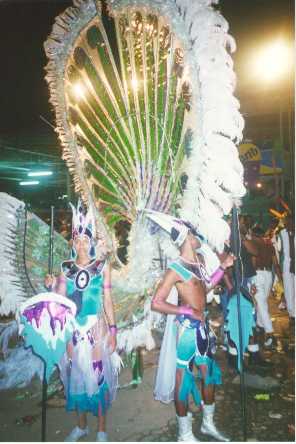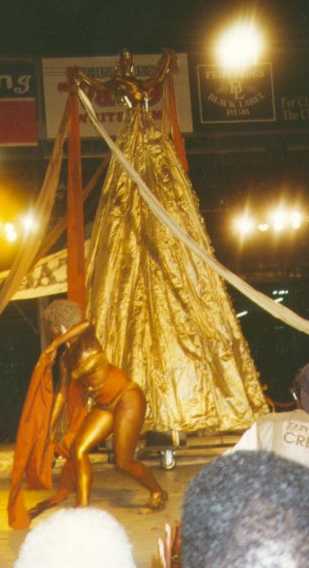Carnival in Trinidad
The Greatest Show on Earth?




We arrived in Trinidad the week before Carnival. The anchorage at Chaguaramas was absolutely packed with yachts - literally hundreds. It was exceedingly difficult to find an acceptable place to drop the hook. We ended up a long way out which was quite an inconvenience, as our outboard would only work sporadically.  Steve and Sue on Oleander would sometimes give us a lift in, although their outboard also had its problems. The first job, of course, was to clear Customs and Immigration. In those days they were located in a couple of shacks in what appeared to be a building site. There was a long queue of yachties waiting outside immigration to check in, filling out their forms in quadruplicate. Sue and I waited for what seemed like hours. The immigration official closed up at lunch time, then opened again later. Eventually we got to see him. He was thoroughly charming, but totally oblivious to the queue and the time we'd been waiting. The customs were less charming (they usually are in Trinidad) but at least we didn't have to queue for so long.
Steve and Sue on Oleander would sometimes give us a lift in, although their outboard also had its problems. The first job, of course, was to clear Customs and Immigration. In those days they were located in a couple of shacks in what appeared to be a building site. There was a long queue of yachties waiting outside immigration to check in, filling out their forms in quadruplicate. Sue and I waited for what seemed like hours. The immigration official closed up at lunch time, then opened again later. Eventually we got to see him. He was thoroughly charming, but totally oblivious to the queue and the time we'd been waiting. The customs were less charming (they usually are in Trinidad) but at least we didn't have to queue for so long.
Trinidad has become quite a major centre for yachties. It has several advantages; firstly it is below the hurricane belt, seondly the cost of living is very cheap by Caribbean standards, and thirdly there are good facilites for getting things done. As a result a large number of boats (largely but not exclusively American) have virtually taken root there, so the place has more of a sense of community than most other anchorages. If you were feeling uncharitable, you could call it a floating trailer park.
At Chaguaramas, virtually everything you need is on site at the various boatyards, including a reasonable selection of bars and eating places, and a couple of supermarkets. It's not really necessary to venture outside the perimeter unless you want to, and some yachties very rarely do so. If you do, there is good and cheap transport to Port of Spain both on the municipal buses and the privately-owned "maxis". Car hire is also very reasonably priced (although the quality of the vehicles can vary somewhat), and there are at least three car hire firms in the marina complexes. At Carnival time, of course, everything is far busier than normal, and hire cars are at a premium.
The yachties also arrange quite a wide variety of outings and social events, ranging from a weekly general knowledge quiz to bird-watching and turtle-watching expeditions, book swaps, barbecues and so on. At 8 every morning there is the "net" on the VHF, where you can advertise a social event, ask for advice, or advertise articles for "swap, barter or trade".
Although Carnival itself only lasts a couple of days in February, the run-up to it starts early in the new year and the aftermath lingers on for a couple of weeks.  Before the main Carnival, there are a number of competitive musical events to find the leading Pan band, soca monarch, calypso monarch and so on. We went to the Pan finals, which is quite an experience. The steel pan (as a musical instrument) was invented in Trinidad, and is taken very seriously there. There are a large number of pan groups from all over the island, and competition is fierce. The bands can have dozens of players, with pans of all sizes and various other metal objects which are banged rhythmically in the "engine room" or rhythm section of the band. They make a very loud noise, and their virtuosity is impressive. The music is all learnt by heart (or by ear) - the players don't (or can't) use sheet music. It was a notable occasion - won on this occasion by the Amoco Renegades - but not something I would necessarily want to attend on a regular basis. In truth, after a while in the Caribbean, you get "panned out". The music is so ubiquitous that you get pretty tired of it. It is also fair to say that the repertoire of most of the pan groups appears fairly limited. But if you like the idea of pan music, Trinidad is certainly the right place, and Carnival is the right time.
Before the main Carnival, there are a number of competitive musical events to find the leading Pan band, soca monarch, calypso monarch and so on. We went to the Pan finals, which is quite an experience. The steel pan (as a musical instrument) was invented in Trinidad, and is taken very seriously there. There are a large number of pan groups from all over the island, and competition is fierce. The bands can have dozens of players, with pans of all sizes and various other metal objects which are banged rhythmically in the "engine room" or rhythm section of the band. They make a very loud noise, and their virtuosity is impressive. The music is all learnt by heart (or by ear) - the players don't (or can't) use sheet music. It was a notable occasion - won on this occasion by the Amoco Renegades - but not something I would necessarily want to attend on a regular basis. In truth, after a while in the Caribbean, you get "panned out". The music is so ubiquitous that you get pretty tired of it. It is also fair to say that the repertoire of most of the pan groups appears fairly limited. But if you like the idea of pan music, Trinidad is certainly the right place, and Carnival is the right time.
The most prevalent music in Trinidad and much of the Southern Caribbean is soca (the name comes from Soul/Calypso). It's good party music, with an infectious rhythm, and is the perfect complement to the visual part of Carnival.  It doen't appear to be particularly well-known outside the area - I dare say it will catch on some day, with some some soca band getting catapulted to the top of the European or American charts. The Trinidadian people are fairly evenly divided between Afro-Caribbean and East Indian ancestry, and this divergence is reflected in some of the music, as well as in many other areas of the country's culture.
It doen't appear to be particularly well-known outside the area - I dare say it will catch on some day, with some some soca band getting catapulted to the top of the European or American charts. The Trinidadian people are fairly evenly divided between Afro-Caribbean and East Indian ancestry, and this divergence is reflected in some of the music, as well as in many other areas of the country's culture.
There is one problem with soca. At Carnival, all the soca bands bring out their new songs. That's great. The trouble is, that's all you're going to hear for the rest of the year. After a while, some of the songs can get on your nerves. One of the ones which fell ito this category in 97 was "Who let the dogs out - WOOF WOOF WOOF WOOF?". Even a year later, I can't entirely get it out of my head.

Carnival proper starts with J'ouvert. This "old mas" begins in the small hours of the morning, when the mas (masquerade) bands and other revellers parade into the Capital, Port of Spain, dressed in old (and often skimpy) clothes, accompanied but trucks with massive speaker systems. During the parade, just about everyone on the parade gets covered with mud, oil, paint and assorted gunge. The whole occasion has a wild pagan air about it, and lasts until shortly after dawn. Then the revellers go home (or back to their mas camp), wash off, and put on their spectacular costumes for the main Carnival procession. You have to admire their stamina....
It should be pointed out that while the atmosphere at J'ouvert is generally extremely friendly, it is not uncommon for people to have money or valuables stolen, sometimes at knifepoint. So do be sensible.. You are probably safer with a group of friends than alone. Females are also likely to get "wined", i e subjected to the local dancing - which is about as close as you can get to having sex while fully clothed.
Some of the costumes for the main carnival are almost unbelievably spectacular. Serious carnivals participants can spend much of the year preparing themselves for these few days, and in some cases virtually bankrupt themselves in the process.
You can watch from anywhere along the route (grandstands have been set up by the roadside) or go to the Queen's Park Savannah (huge central park) which is the ultimate destination of the bands and where the main "performances" take place. the whole of the Savannah is taken over by Carnival, with car parks, hundreds of stalls selling food and drink, and the procession route itself. It's packed with people but the atmosphere is festive, and the experience is worth crossing an ocean to see.
If you arrive in time, you can join one of the mas bands, buy a costume, and join in carnival yourself. Another feature of Carnival is the fetes, or parties. Many of these are organised by the mas bands and other organisations, and they tend to last until the morning with loud soca music and plenty of rum. Rum is cheap, of course, particularly if you buy a bottle or half bottle (from the bar) rather than individual drinks, which is an entirely normal thing to do.
After Carnival itself, there is a "Champs in Concert event" where you can see some of the award-winning performers. We never went to this (probably too shattered after Carnival), but by all accounts it was well worth going to.


